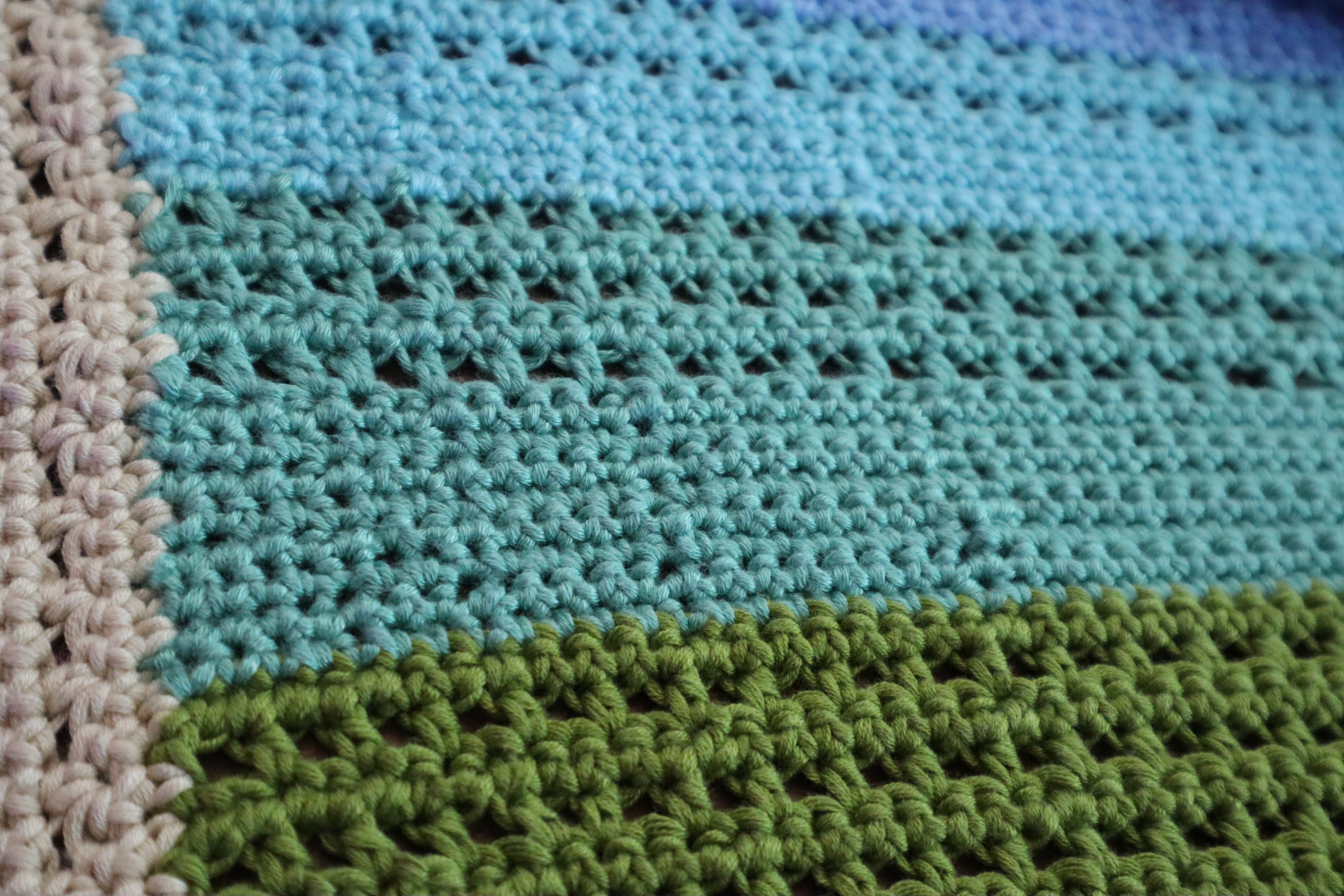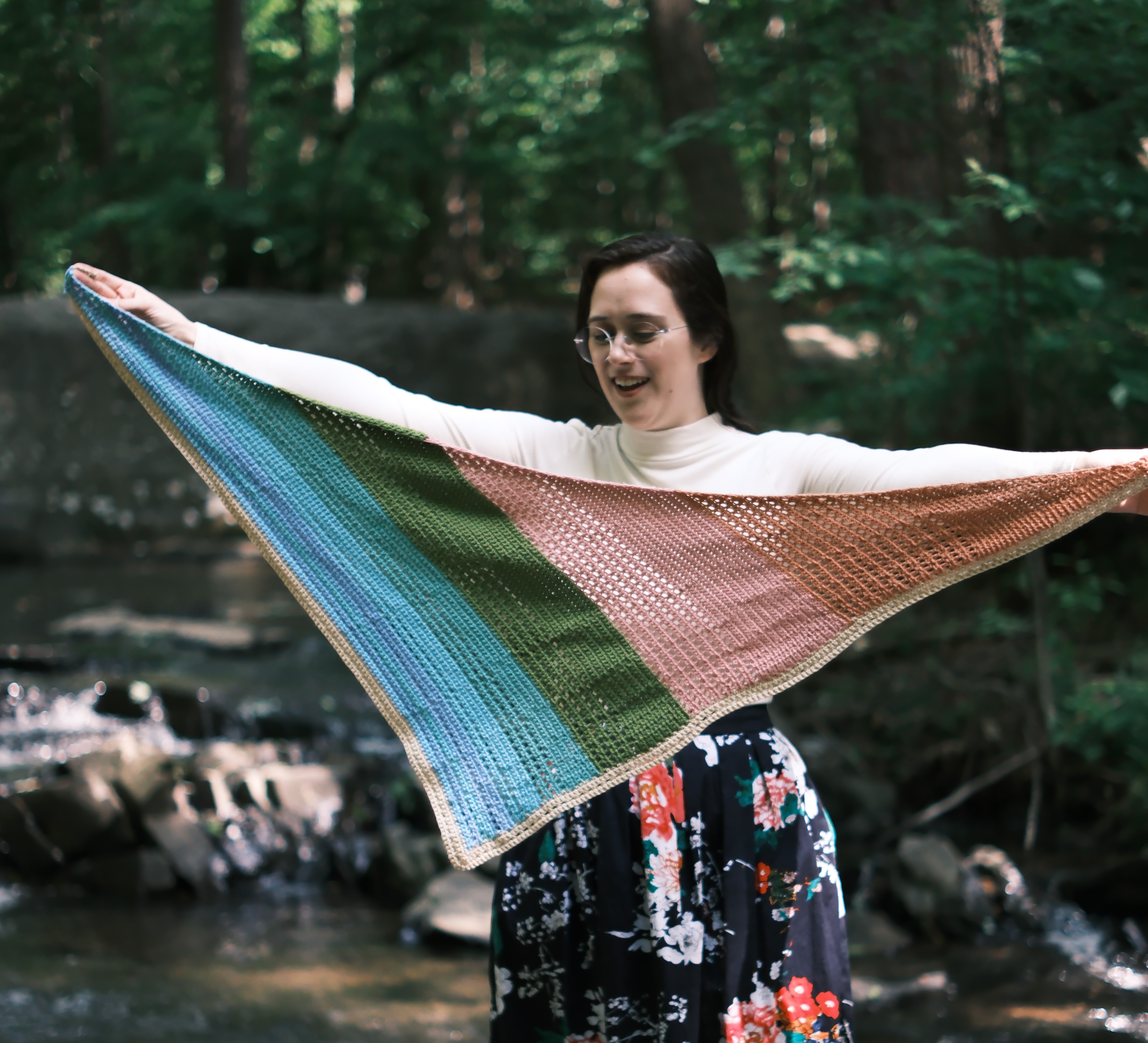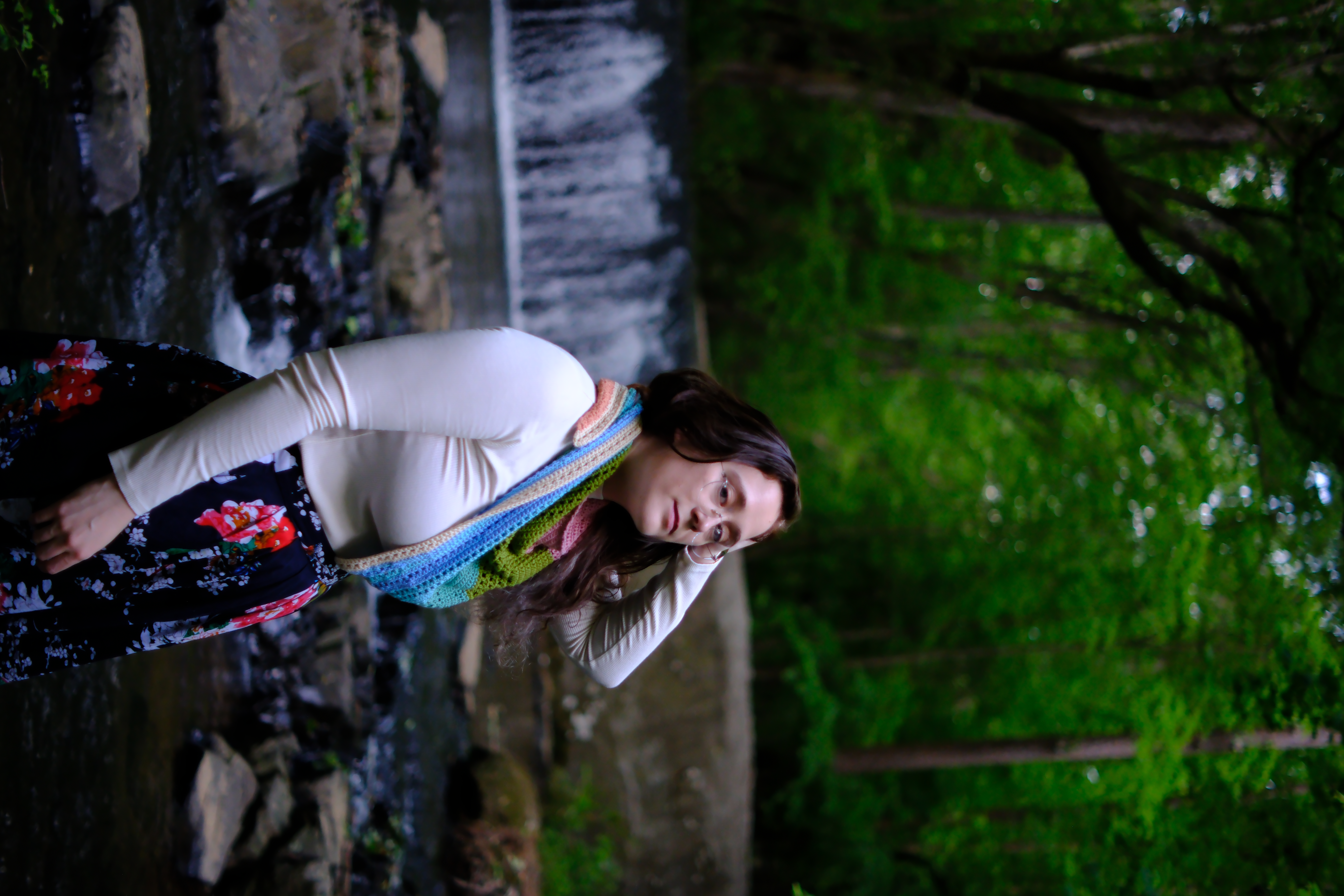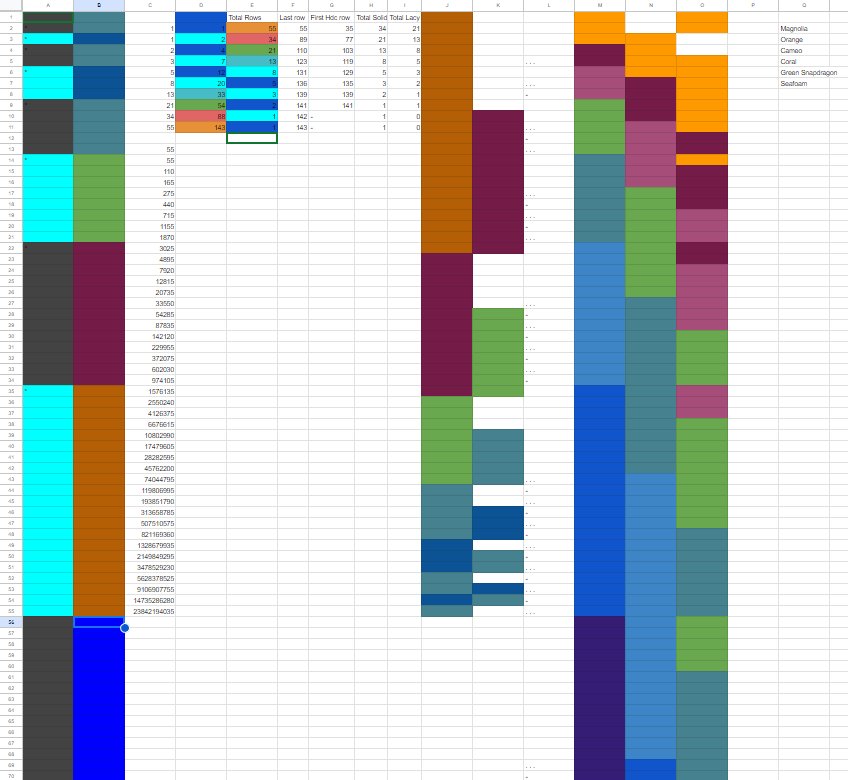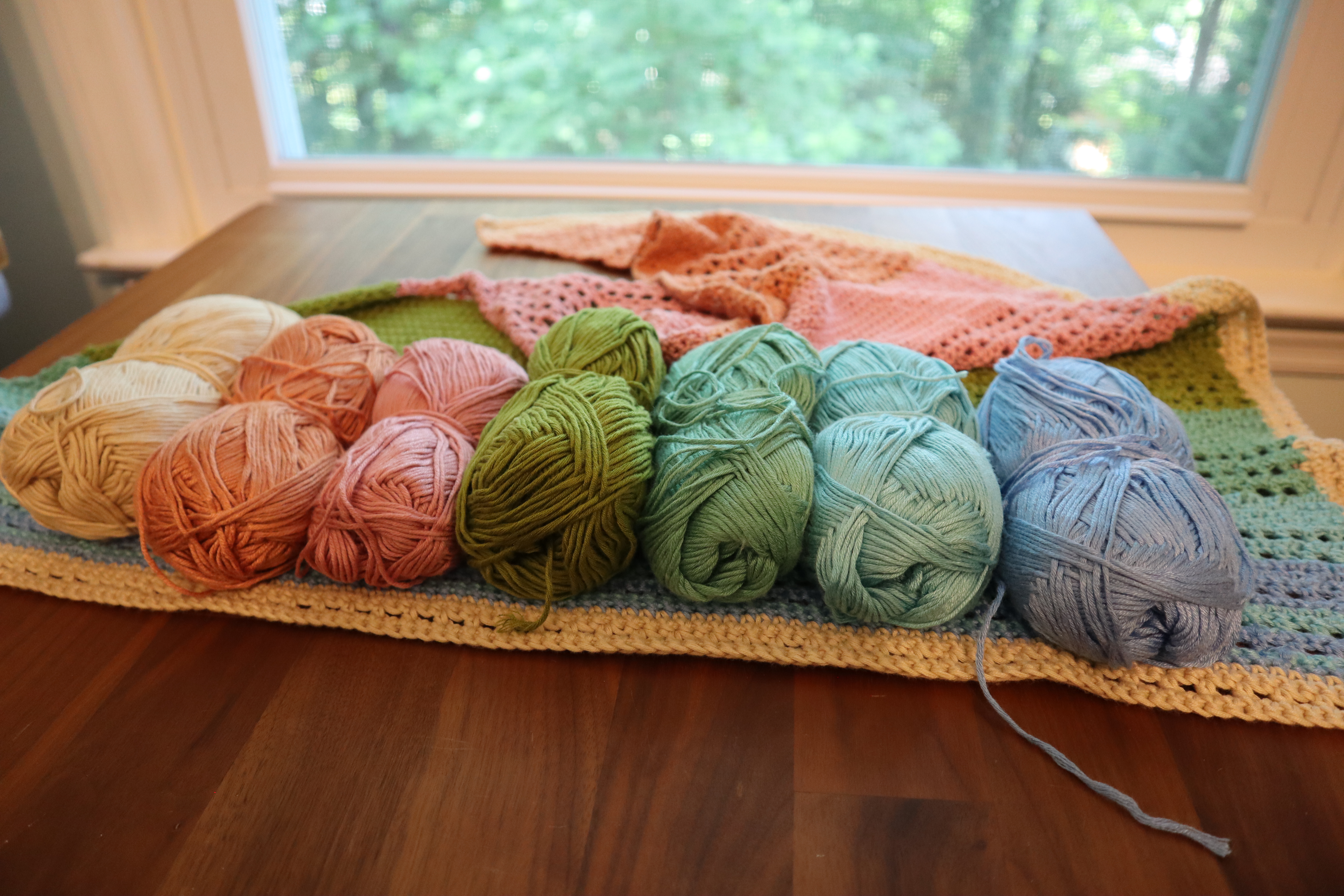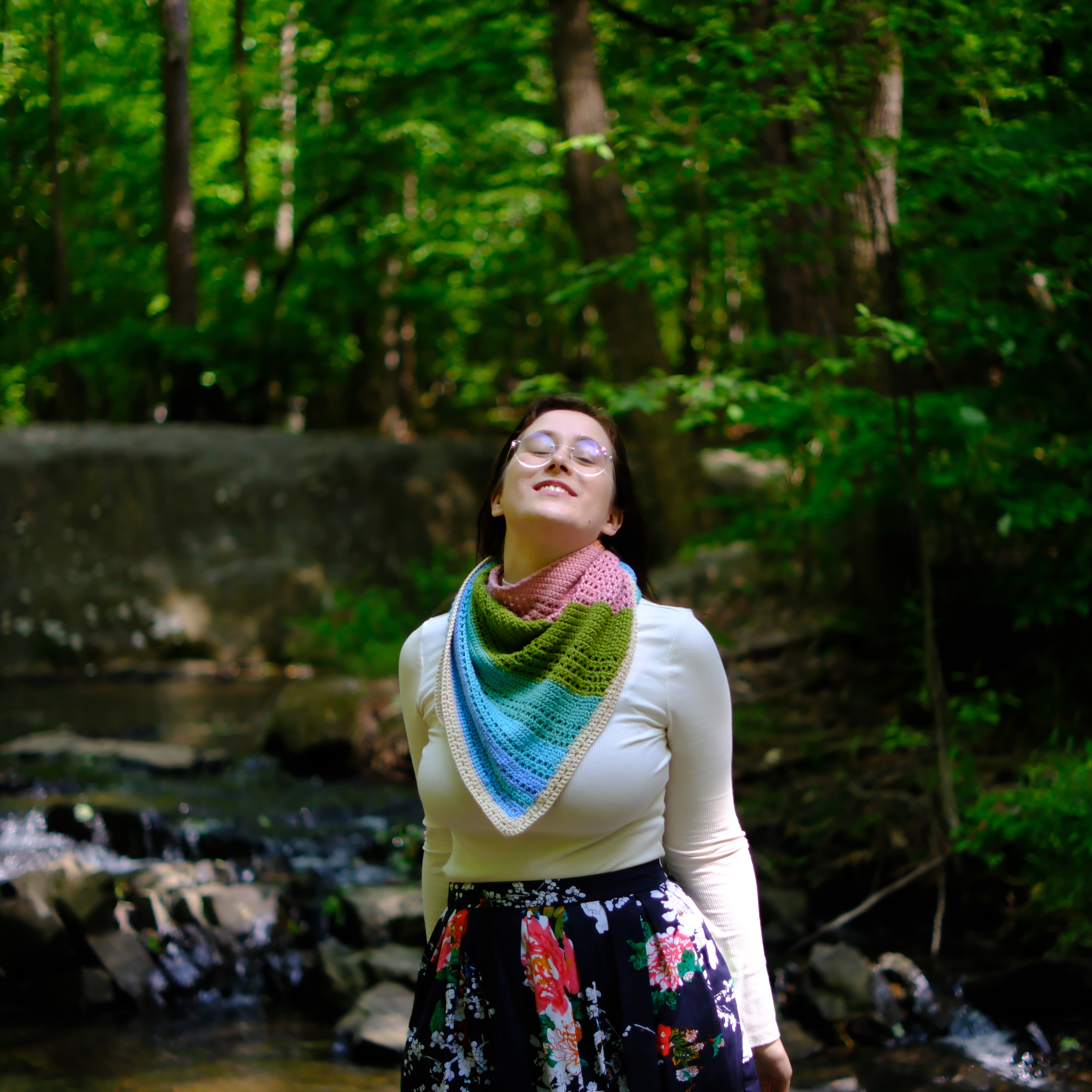
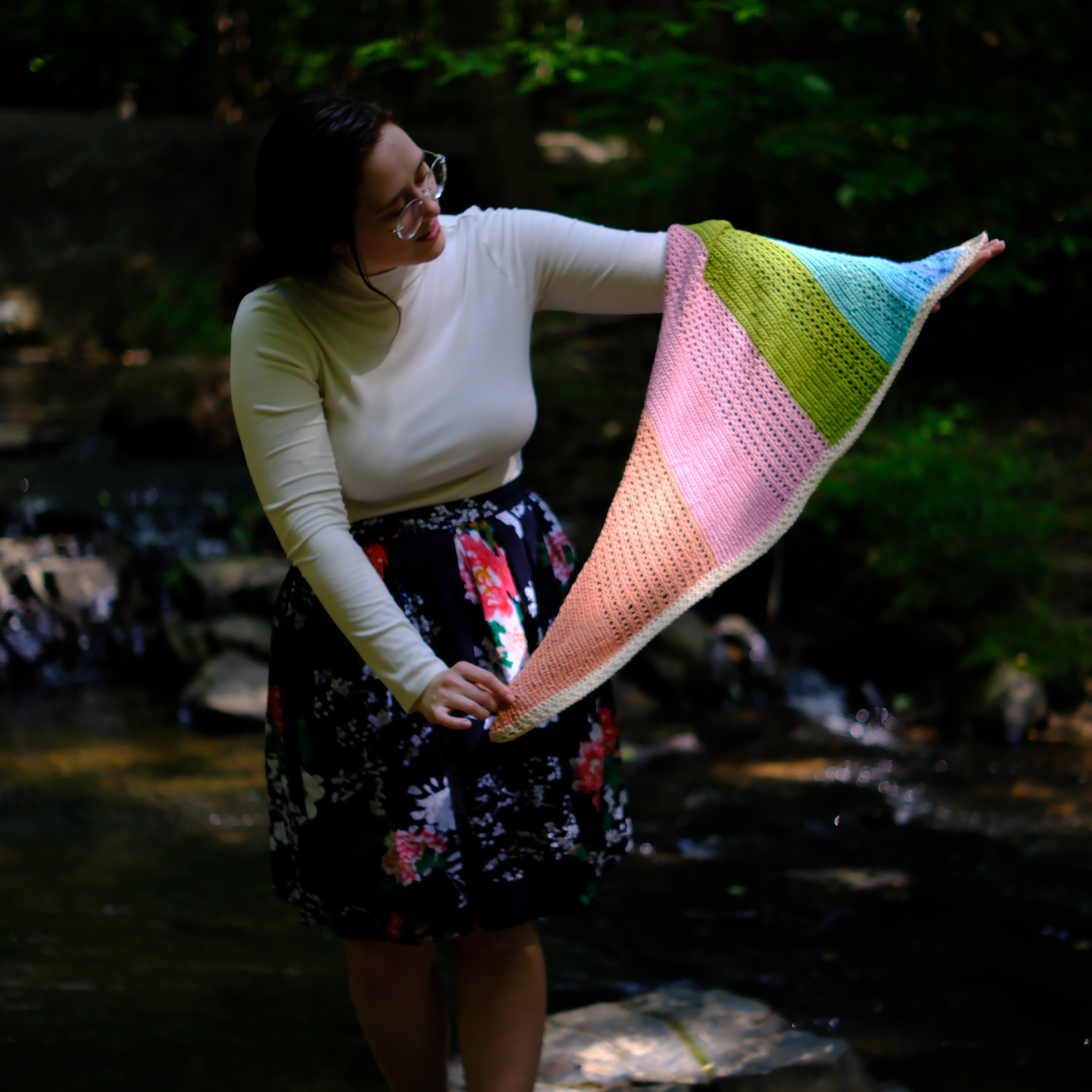
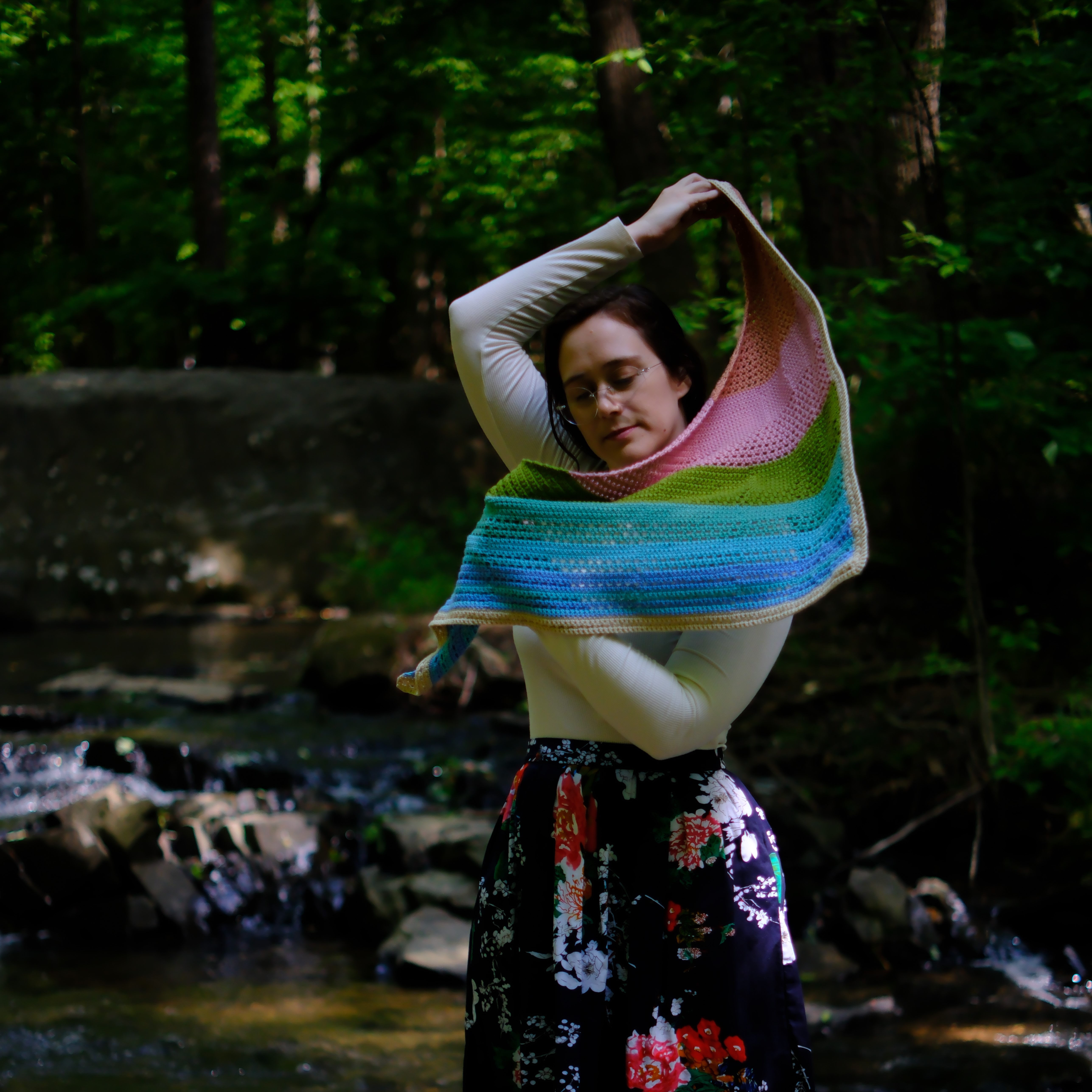

The Fibonacci Shawl is a gorgeous design that attempts to express Fibonacci’s sequence through yarn. Each stripe of color represents a number from Fibonacci’s sequence. Let’s look at teal, for familiarity. There are 13 rows split into two sections - 8 solid rows, and 5 lacy rows. In this way, we can express that 13 is the sum of 8 and 5. Each solid section is the larger of the two numbers, so as we move down the sequence, we see the lacy section become the solid section of the next number in the sequence.
Instead of constructing the shawl from the bottom up, or top-down, it’s a right triangle with one straight side. I felt this better expressed the concept of a number sequence because we’re starting from a straight line (0) and expanding in a single direction. Without the mirrored effect, it’s easier to see how the sequence increases as well, but this does mean I need more numbers from the sequence to make a big enough shawl to wear.
This also allowed me to have a 0 to orient the work from. On each row, each stitch that’s a Fibonacci number is reversed which adds the tiniest visible stripe in the solid sections.
Finally, I reinforced the concept of 0 (and tidied the edges) by adding a border on the two sides that would represent 0. The bottom, where the color sequence begins, and the side, where our row count begins.
The result is a beautiful shawl that’s secretly hiding a detailed math lesson. ❤️
History
This all started with Toni Lipsey’s Rancher shawl. It’s GORGEOUS, with an amazing fade from warm to cool that’s only possible with that specific colorway that was unfortunately unavailable. This got me thinking about a shawl with small stripes of color, which made me think of Fibonacci’s number sequence!
Fibonacci’s number sequence is a sequence of numbers where each number is the sum of the two previous numbers!
1, 1, 2 (1+1), 3 (2+1), 5 (3+2), 8 (5+3)…. and so on and so forth. In software development, we like to use generating it as an easy puzzle, and we use the sequence itself to estimate the complexity of work (because we like to be complicated).
Searching for existing patterns yielded disappointing results. They are all knitting, and I can only crochet, but more importantly, none of them scream Fibonacci sequence to me. The interchanging striped colors really muddy the message for me. Why do they do that?
Well, all shawls are constructed the same way. They start with a small triangle and increase to a larger triangle. You use the least amount of yarn per row at the beginning of the shawl, and the most per row at the end. If I started my shawl at 1, (or if they did) then we’d have 2 lonely little stitches in one color before the next color change, and final stripe would be 55 rows of 89-143 stitches. My yarn usage and color balance would be way off!
The other patterns solve this by having interchanging stripes of Fibonacci’s sequence, but we’ll fix it by reversing the sequence! This means that our final number of the sequence needs to come first, and as soon as that section is done, we’re locked in on the shawl size. There was a lot of math and planning and Google spreadsheets, and a brief period where I thought about expressing recursion using marling, but ultimately, I landed on 55 starting rows, with a final row count of 143. This was a little small for a shawl, but the alternative was 232!!
The next modification was to the shape. Instead of the obtuse triangle expanding on both sides, I wanted to use a right triangle to make it easier to convey as a number sequence. The straight edge makes it feel more like an expanding number sequence, because it’s not mirrored or angled.
I found a good example of how to make a simple triangle shawl, but I wasn’t loving the mesh. Too complicated, hard to convey my sequence, and it’d be too chilly in the evenings. That’s when the bronwyn shawl brought my next inspiration. The beautiful sections of solid and lacy space had me thinking about how I could convey which numbers summed to equal my Fibonacci number! I thought it would look best if I had the larger number be the solid section, and that section always come first. I was really excited for the lacy section (the smaller number) to equal the size of the solid section (the larger number) of the next number in the sequence! Unfortunately, due to the half-double crochets in the lacy section, this didn’t pan out in reality. This is the number one thing I’d change if I was making this shawl again.
Now that I’d settled on a design, it was time to buy yarn! I selected some lion brand truboo yarn for the softness and sustainability. Unfortunately their color choices are… limited. The green section is actually cotton bamboo because I hated all the greens from truboo. The cotton bamboo was a joy to work with. It was smooth, the yarn didn’t split, and the color has a lot of depth. The truboo was spitty, shiny, and is already fuzzy. If I made this again, I’d make it with cotton bamboo. It’s wonderfully soft and plush with great stitch definition.
Pattern
Yarn
- Truboo Sienna
- Truboo Cameo
- Cotton Bamboo Snapdragon
- Truboo Seafoam
- Truboo Aqua
- Truboo Blue
- Border - Cotton Bamboo Magnolia
Stitches
| ch | chain |
| sc | Single crochet |
| 2sc | Single crochet increase, put 2 single crochets in one stitch from the previous row |
| rsc | Reversed single crochet, make your single crochet in the wrong side instead of the right side of the fabric |
| 2rsc | Reversed single crochet increase, put 2 reversed single crochets in one stitch from the previous row |
| hdc | half-double crochet |
| 2hdc | Half-double crochet increase, put 2 half-double crochets in one stitch from the previous row |
Pattern Concept
You’re going to increase on one side every row. For each Fibonacci number, counting from the non-increase side, you’ll reverse the single crochet. Each stripe of color is split into 2 sections - solid single crochets for the larger number, and alternating rows of single crochets and half-double crochets for the smaller number. Always start with a row of hdc/ch when changing to the next number. Ignore all the turning chains, just use them in the border, or pretend they don’t exist.
Here’s a table of when you swap colors and start with the lacy hdc/ch section.
| Total Rows | Last Row | First Hdc row | Total Solid Rows | Total Lacy |
|---|---|---|---|---|
| 55 | 55 | 35 | 34 | 21 |
| 34 | 89 | 77 | 21 | 13 |
| 21 | 110 | 103 | 13 | 8 |
| 13 | 12 | 119 | 8 | 5 |
| 8 | 131 | 129 | 5 | 3 |
| 5 | 136 | 135 | 3 | 2 |
| 3 | 139 | 139 | 2 | 1 |
| 2 | 141 | 141 | 1 | 1 |
| 1 | 142 | - | 1 | 0 |
| 1 | 143 | - | 1 | 0 |
Rows
- Row 0: Make a magic circle, ch 2.
- Row 1: rsc 2 in magic circle, ch 2, turn (2)
- Row 2: 2rsc, rsc, ch 2, turn (3)
- Row 3: rsc 2, rsc and sc in last rsc of previous row, ch 2, turn (4)
- Row 4: rsc and sc in last sc of previous row, rsc 3, ch 2, turn (5)
- Row 5: rsc 3, sc, rsc and sc in last sc of previous row, ch 2, turn (6)
- Row 6: 2sc, rsc, sc, rsc 3, ch 2, turn (7)
- Row 7: rsc 3, sc, rsc, sc, sc and rsc in last sc of previous row, ch 2, turn (8)
- Row 8: sc and rsc in last rsc of previous row, sc 2, rsc, sc, rsc 3, ch 2, turn (9)
- …
- Row 34: sc and rsc in last sc of previous row, sc 12, rsc, sc 7, rsc, sc 4, rsc, sc 2, rsc, sc, rsc 3, ch 2, turn (35)
- Row 35: hdc, ch and skip a stitch repeat 16 times hdc, ch but do not skip a stitch, hdc, ch 2, turn
- Row 36: 2sc, rsc, sc 12, rsc, sc 7, rsc, sc 4, rsc, sc 2, rsc, sc, rsc 3, ch 2, turn (37)
- Row 37: hdc, ch and skip a stitch repeat 17 times hdc, ch but do not skip a stitch, hdc, ch 2, turn
- …
- Row 55: hdc, ch and skip a stitch repeat 26 times hdc, ch but do not skip a stitch, hdc, tie off (56)
- Row 56: This row is a color change. The honorable thing to do is work in reverse towards the straight edge, but you can start back at 0 because it’s a color change, so that’s what we’ll do.
- Row 56: rsc 3, sc, rsc, sc 2, rsc, sc 4, rsc, sc 7, rsc, sc 12, rsc, sc 20, rsc and sc in the hdc from the previous row, ch 2, turn
- Row 57: 2sc, rsc, sc 20, rsc, sc 12, rsc, sc 7, rsc, sc 4, rsc, sc 2, rsc, sc, rsc 3, ch 2, turn
Hopefully at this point, you can use the instructions and color chart to finish the pattern!
Border:
- Start at the first row, go along the straight side of the shawl, put one sc in each row. 2sc in the last row, turn the work so the last row is ready to work. Place one sc in each stitch of the last row. ch 2, turn.
- sc in each stitch along one side. 2sc in the center of your 2sc from the previous row. sc in each stitch of the other side. ch2, turn.
- hdc, ch and skip a stich repeat for each stitch on one side. 2hdc in the center of your 2sc from the previous row. ch and skip a stitch, hdc repeat for each stitch on this side. ch 2, turn.
- sc in each stitch along one side. 2sc in the center of your 2hdc from the previous row. sc in each stitch of the other side. ch2, turn.
